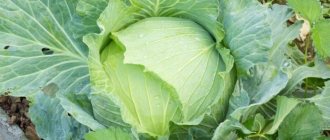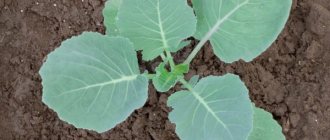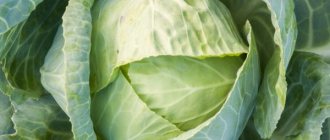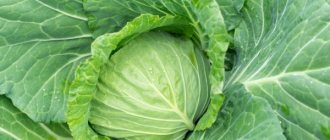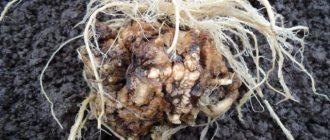How to sow cabbage correctly before winter so that it germinates successfully several weeks earlier than usual, is more juicy, tasty and resistant to pest attacks? Let's understand the intricacies of this process.
Pre-winter sowing of any crop, as is known, differs from the more common spring sowing. If crops are sown in the fall, they go straight into open ground, which significantly saves the summer resident’s time on caring for seedlings. In addition, winter crops do not need watering as badly as spring crops, since they are “watered” by melted snow. And pests will no longer be able to seriously damage such a plant, since by the time they appear, it will have become stronger.
But there are also difficulties in sowing crops before winter. Some plants will not survive, that is, there must be more planting material than usual. The time for sowing must be chosen strictly, which means that you will again have to regularly check the weather forecast. In addition, the cabbage will definitely need to be covered for the winter. If all this doesn't scare you, get started.
Optimal soil structure for growing cabbage
One of the most important activities is soil cultivation. Processing methods are the subject of much heated debate. Some consider the old-fashioned system with reservoir turnover to be correct. Others call it, no less, a crime against the land-nurse. They cite the example of the American aborigines, who grew corn and potatoes using only a digging stick and a hoe. To understand what's what, you need to know what properties the land on our site has, and what we would like to make it. Plants, as we know, have different needs, but most vegetables perform best in light, nutritious soils with good structure (plenty of pores that retain water and oxygen, with particles that absorb and retain nutrients), slightly acidic or similar to a neutral reaction (pH from 6 to 7). This is ideal, but in practice it is not so easy to achieve.
Latest articles about gardening
Salting cabbage in February 2021 according to the lunar calendar
How to treat pepper seeds with hydrogen peroxide before planting seedlings?
Treating pepper seeds with potassium permanganate before planting seedlings
Seedling care: watering and pest protection
Seedlings need to be watered at least twice a week. Moreover, about 8 liters of water are consumed per square meter. It's better to do this in the morning.
Once every 10 days you can feed cabbage with sulfate solutions or tinctures of mullein and urea. After each such fertilizer, the soil must be loosened.
Spud the seedlings when they are 20 days old, and again after another 10.
Seedlings need to be fertilized
For active growth of cabbage, seedlings can be fed from time to time with various fertilizers. These can be superphosphate, potassium, and nitrogen fertilizers.
Wood ash can be used as fertilizer. Cabbage leaves are sprinkled with it. Plus, such fertilizer will protect plants from various pests, although they are quite rare in greenhouse cultivation.
If you add naphthalene to the ash, you can get rid of cabbage flies, white flies and cutworms. Tobacco dust with lime will help repel the cruciferous flea beetle.
These manipulations stop with tying the head of cabbage. Further fight against parasites, if any, preferably manually, destroying the parasites themselves or their eggs. You can also use traditional methods: decoctions based on wormwood, tomatoes against caterpillars and cutworms and other pests. But aphids, for example, are destroyed by tinctures of hot pepper, garlic, tobacco or dandelions.
With proper greenhouse cultivation of cabbage, problems with seedlings rarely occur. But you should still know the enemy by sight. There are several most common diseases that affect cabbage:
- Clubroot cabbage
Black leg - is expressed in the rotting of the stem.
- Downy mildew - spots and plaque appear on cabbage.
- Clubroot - swellings and growths appear on plants.
But if you pre-heat the seeds, as indicated above, such problems should not arise.
One of the main rules for caring for cabbage is to avoid shadows. This plant is light-loving. Also, a high yield will be ensured by regular watering and ventilation of the greenhouse.
Is it necessary to dig up the soil for cabbage in the fall?
Autumn digging is not useful for all types of soil. On sandy crumbly soil it does not have a positive effect, but on heavy clay soil it is extremely useful.
Digging improves the structure of clay soil. Pores, air voids, where oxygen penetrates, are formed in it. It is very important for root respiration and nutrient absorption by plants. With a lack of oxygen, nutrients become inaccessible to plants, and plant productivity decreases.
Autumn digging of the soil reduces the infestation of the garden with pests and diseases. It destroys the passages and nests of pests, opening access to cold air. Lumps turned out to the surface freeze better, this contributes to their partial disinfection. Digging reduces the number of annual weeds. Small seedlings of weeds easily die after digging, which will make it easier for you to weed next season.
Snow moisture is used rationally. More snow accumulates on the lumpy surface of the bed after digging. At the same time, when the snow melts, the water does not flow down the sides, but enters the pores and wells formed after digging and is absorbed deep into the soil. Dig the beds to a depth of approximately 15-20 cm, turning the clumps over if possible so that the weed seedlings are at the bottom.
Harvest
You need to harvest early cabbage when a loose head of cabbage has formed. For medium and late varieties, the head should be quite dense. But the main thing in this matter is not to keep the head of cabbage on the stem so that it does not start to crack. Otherwise, such cabbage will not last long.
By the way, with a careful cut of the head, the plant may well form a new head of cabbage.
Growing cabbage in a greenhouse provides much more guarantees for a positive result than in open ground. After all, all the necessary temperature conditions are observed in the greenhouse. And determination, lack of laziness and compliance with the above simple rules guarantee an excellent harvest.
leave a comment
Your email will not be published. Required fields are marked *
Name *
five × 3 =
A comment
The following HTML tags and attributes can be used:
pro-dachu.com
Sowing green manure in the fall for planting cabbage
If green manure (phacelia, oats, peas) were sown on the site in June - July, and by September they had gained color, then it’s time to mow and dig them up. This procedure will be equivalent to applying nitrogen at a dose of 300 t/ha. The budding phase is the peak accumulation of beneficial nutrients in green manure crops. Also, green manure should not be allowed to be inseminated, otherwise next year they will germinate as weeds.
In September you can sow winter rye, oats, vetch and rapeseed. These green manures are no longer mowed, but left to winter. Plants left for the winter, in addition to the main beneficial properties inherent in specific green manure crops, also have other advantages:
- contribute to the retention of snow cover on the soil surface;
- protect nutrients in the soil from being washed out by melt water;
- form living mulch and protect the soil from freezing.
Advice from experienced gardeners
Having prepared the soil as described above, begin cutting furrows. Cover the bed with film or boards. Otherwise, rains may wash it away. When the cold weather sets in, you will open the bed and sow cabbage in the designated areas.
Making grooves and filling them with frozen soil is difficult. Make this work easier for yourself. Collect loose soil in boxes or buckets in advance. Stock up on humus and leaves. Keep supplies in a warm place. Use a shed or covered greenhouse for this purpose. Keep them there until the weather is suitable.
Related article:
Growing Broccoli: 8 Helpful Tips
Experienced gardeners know how to make their work easier. At the right time, they scatter the planting material evenly over the bed. Using a rake, embed it into the soil. For this purpose, also use stored soil and foliage.
Our method involves planting dry material. There is no need to pre-soak or process it. Such actions stimulate growth, and in this case we do not need it. Seeds must be of high quality, large, and of the same size.
Applying manure to the ground under cabbage in the fall
Manure is applied in autumn or early spring. It all depends on what crop you are going to grow. It is better to apply manure to early vegetables (cabbage, potatoes) in the fall, and to late vegetables during early spring digging.
If in the spring you have to use fresh decomposed manure, then you can grow pumpkins and cucumbers in these beds. But onions, cabbage, carrots, and green crops are planted only in the second year after applying manure. In the fall, when digging the soil, it is better to apply phosphorus fertilizers, since it takes a long time for them to reach the roots.
When to start
The most common mistake is failure to meet deadlines. It is for this reason that the seeds die in winter, and the harvest leaves much to be desired. Gardeners recognize the method as not working and stop using it.
Related article:
Tips for super-large heads of cabbage
The most common mistake is failure to meet deadlines.
Cabbage planted in the fall should begin to grow only in the spring. If you sow too early, the seeds will begin to hatch and die at the first frost. Wait for stable frosts. The soil should freeze and no longer thaw. There may be snow on the beds, but not much. Study weather forecasts carefully. This will help you choose the right time.
Applying mineral fertilizers to the soil in autumn for cabbage
If fussing with manure is not for you, then you can use ready-made mineral fertilizers, the packaging of which usually provides full information about the required quantity and method of use. The products should be scattered evenly throughout the garden and then dug up. The main nuance when applying autumn fertilizing is that it should contain a minimum of nitrogen. It is very convenient to use special complex fertilizers prepared just for the autumn period. They will be called that way, for example, “Autumn”, etc. They have a balanced content of phosphorus, calcium and potassium and virtually no nitrogen. In addition, you can immediately select fertilizer for a specific type of plant in the store.
Planting seedlings in open ground
You can plant cabbage on the ground when the seedlings have three or four leaves. But first we need to prepare the place where we will plant it. We will first dig up the soil and fertilize it if necessary. We make holes at a distance of 50 centimeters from each other. When you dig cabbage from the nursery, pay attention to the root of the seedling. If the root is white, then plant it boldly, but if the root is black, it means that the seedlings are sick with black root, the current seedlings cannot be planted. We plant one cabbage bush in each hole, water it with water, but not from a watering can, but with a jar under the root, so as not to wet the leaves, otherwise our cabbage will die. Cabbage should be planted in the evening, when the sun is no longer shining so clearly.
Adding compost to the ground under cabbage in the fall
Humus is most loved by all nightshades, onions, and cabbage. Adding compost is a must to maintain a high level of soil fertility. The compost mixture achieves improved aeration by attracting earthworms and other natural cultivators. In addition, compost contains a large amount of nutrients that are necessary for the growth and development of plants. With the help of digging, it is possible to quickly create a system of vertical passages as the most convenient for root crops. Compost made from undecomposed hard stems of perennial flowers is especially suitable for this.
Making a nursery
White cabbage should be grown as seedlings. To do this you need to make a nursery. The nursery should be made in a bright place protected from the wind. To begin, we make a box 1 meter wide, 1.5 meters long and 50 centimeters high. We lay a layer of manure on the bottom, and pour about 20 centimeters of earth on top. We loosen the earth so that there are no lumps and pour boiling water over it (to kill harmful substances). Cover tightly with film and leave for several days so that the earth warms up well.
Answers to frequently asked questions
Do I need to add anything to the hole at all?
Not at all necessary. Let's say you have a plot with black soil or fertile loam. You treat it regularly, it is free of parasites and weeds. Then you don’t need to pour anything. After all, an excess of drugs is also harmful. In all other cases, adding a small amount of fertilizer will not hurt.
What fertilizer is best to add?
Any, of your choice. Cabbage equally loves organic matter and minerals. The main thing is not to exceed the dosage.
Is it necessary to deoxidize the soil?
Not always, only if the site has acidic soil. In all other cases, liming is not necessary.
